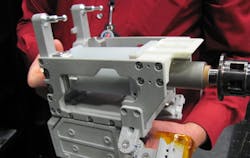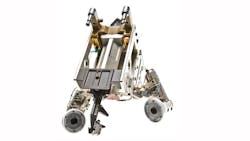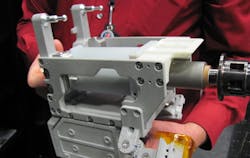The RRM module is the size and shape of a washing machine. Now attached to CSA’s maintenance robot Dextre on the International Space Station (ISS), it’s equipped with four tools and covered inside and out with replicas of common satellite parts and interfaces. The module’s purpose is to give Dextre a medium to prove how well robots can service and refuel satellites in orbit.
Solid Concepts Inc., Valencia, Calif., rapid-manufactured prototypes of the frames and mechanical linkages for the module’s multifunction tool, safety-cap removal tool, cutter and manipulator, and nozzle. SLS is appropriate for aerospace-grade prototypes because it makes fine-featured parts from nylon 11, nylon 12, carbon fiber, nylons with glass-bead filler (for light parts), or metals. During SLS, software mathematically slices the part’s 3D CAD file into 2D cross sections. Then the part is built in these cross sections layer by layer with a laser that selectively heats and fuses a powdered material.
For the RRM tool subcomponents, SLS prototypes were made in at least two iterations each and stiffened with aluminum filler for proof of concept prior to final manufacture. Solid Concepts also made two SLS iterations each of the four adapters that fit the RRM tools to Dextre’s arms.
Each of the four tools stows in its own bay on the RRM module until Dextre retrieves it. Engravings on each component give Dextre visual feedback so it can determine what part it has. Two cameras and LEDs mounted on each tool also let mission controllers see what the tools are doing. CSA wrote Dextre’s control software for the RRM trials and tested it with NASA’s Goddard and Johnson Space Center engineers in simulations at MacDonald, Dettwiler, and Associates Ltd. facilities in Brampton, Canada.
A camera built into Dextre’s hand images RRM hardware between sunlight and darkness, providing data that NASA’s Satellite Servicing Capabilities Office is using to develop machine-vision algorithms to accommodate the lighting extremes of orbit. Flight controllers at Goddard Space Flight Center, Johnson Space Center, NASA’s Marshall Space Flight Center, and the Canadian Space Agency’s center monitor current RRM operations. In coming years, Dextre will execute more tasks using the tools and replica interfaces on the RRM module to help engineers develop new technologies and techniques to reduce the risks associated with repairing and repositioning orbiting satellites.



